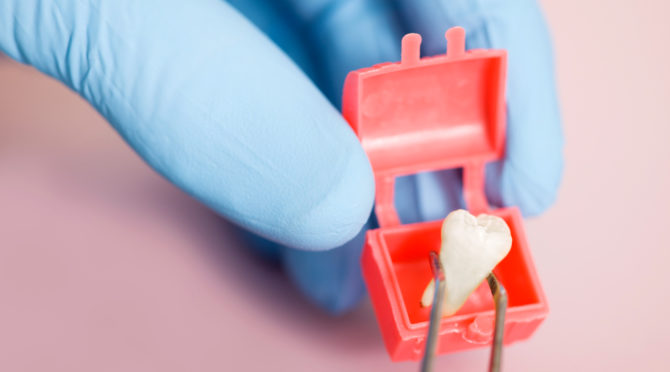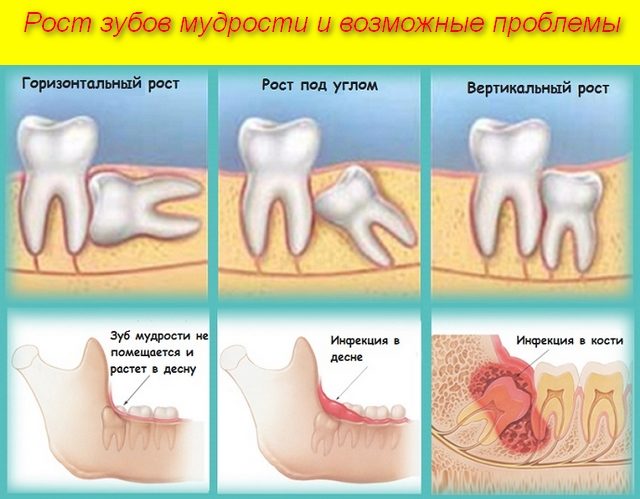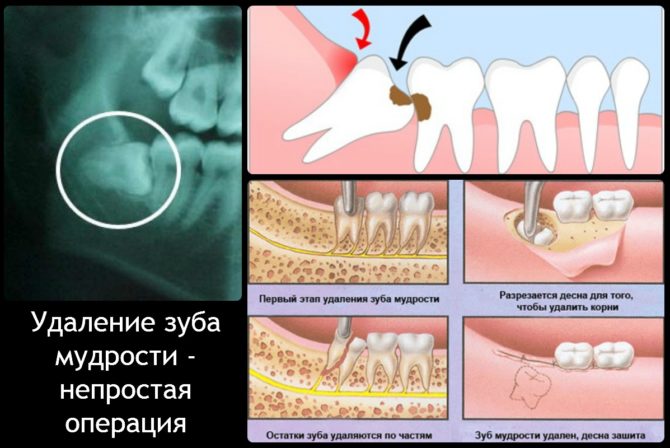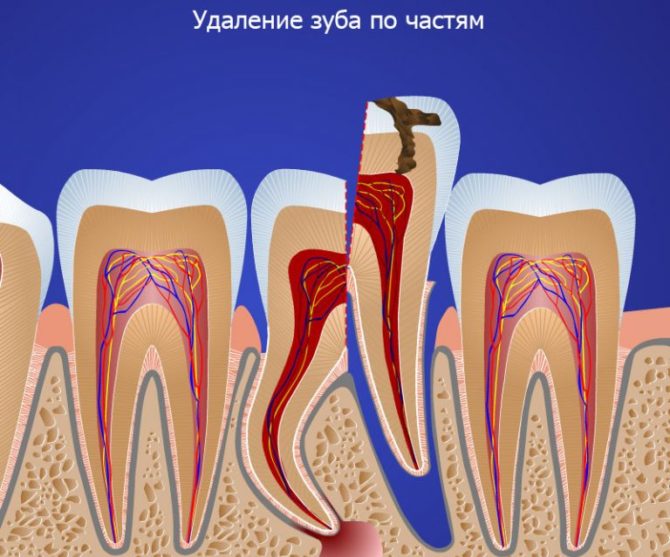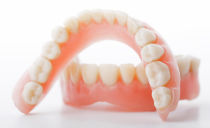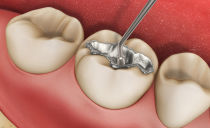Removing a wisdom tooth: indications for surgery, removal procedure
A wisdom tooth or, as doctors say, a third molar creates a lot of problems for a person. If it is improperly located in the oral cavity, cuts in the wrong direction, or is associated with other pathologies, the dentist surgeon performs an operation to remove a wisdom tooth, which is difficult for the doctor and unpleasant for the patient.
Content
Indications for removal
Pain and discomfort in the eighth tooth do not always mean that it needs to be removed. If it does not interfere with neighboring molars, is located evenly and participates in the chewing process, then it is desirable to maintain the integrity of the row.
But such favorable situations are rare, since wisdom teeth are more susceptible to growth pathologies than others. The first reason for this is the cramped space factor, which leads to a change in the direction of growth. The second reason is that primary teething occurs, since milk teeth in childhood do not grow in this place.
All these factors lead to pathologies that leave no other option but to remove the wisdom tooth:
- an abnormal slope due to which a physical effect occurs on an adjacent tooth or gum;
- caries that cannot be treated due to problematic access to the site of the lesion;
- a constant inflammatory process of soft paradental tissues;
- problematic removal of stuck food and, as a result, frequent inflammation of the interdental pocket.
In addition, the figure eight must be removed in case of typical problems, for example, when the crown or root is destroyed, pulpitis.
If inflammation or other abnormalities are found in the area where the wisdom tooth is located, immediately consult a dentist. An emergency removal person transfers much more difficult than planned.
Local anesthesia
One of the common reasons for postponing a visit to the dentist is the fear of pain. Modern painkillers can completely solve this problem or reduce pain to a tolerable level.
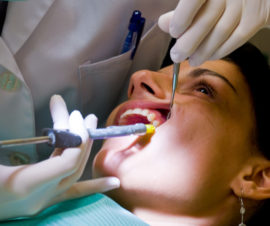 Doctors, removing a wisdom tooth, deform a large volume of tissue, do not apply superficial (application) anesthesia. The usual infiltration anesthesia, in which the drug is administered under the mucosa, is not used when removing the wisdom tooth on the lower jaw. Therefore, usually used chipping of the circular ligament of the tooth - the intraligament method. Or the introduction of the drug to the branches of the ternary nerve is a guide method.
Doctors, removing a wisdom tooth, deform a large volume of tissue, do not apply superficial (application) anesthesia. The usual infiltration anesthesia, in which the drug is administered under the mucosa, is not used when removing the wisdom tooth on the lower jaw. Therefore, usually used chipping of the circular ligament of the tooth - the intraligament method. Or the introduction of the drug to the branches of the ternary nerve is a guide method.
Before choosing painkillers, it is necessary to inform the doctor about taking anesthetics if it was carried out in the last ten days. Otherwise, there is a risk of prescribing a drug with a similar active substance, which will reduce its effectiveness. It is better to compile in advance and have with you a list of all medications taken.
In addition, problems with pain relief can occur for the following reasons:
- individual body reaction to individual drugs;
- taking a drug by a patient;
- extensive purulent process.
In the presence of bronchial asthma, diabetes mellitus, heart failure, hypertension and other serious diseases, the list of acceptable anesthetics is limited. Therefore, you must carefully fill out the patient questionnaire and not hide information about diseases.
Features of removal during pregnancy
During pregnancy, tooth extraction and treatment is recommended in the second trimester. In the first third of the term there is a risk to the fetus, therefore the use of anesthetic is prohibited. And starting from the seventh month, the risk of premature birth increases. therefore in the first, third and subsequent trimesters, the procedure for removing a wisdom tooth is carried out only in emergency cases.
When removing the eighth tooth during the second trimester of pregnancy, the list of acceptable anesthetics for use is significantly limited. They are selected taking into account the impossibility of penetration of the drug through the placental barrier. Not all clinics provide such services, so when making an appointment, you must notify the fact of pregnancy.
With breastfeeding, it is possible to remove a wisdom tooth, but it is necessary to take into account the presence of a short period after the administration of pain medications, when it is impossible to feed the baby in a natural way. Given the fact that after surgery, it may be necessary to take anti-inflammatory drugs and / or antibiotics, it is advisable to postpone this procedure until a later date. But the dentist must make such a decision.
The need for x-ray diagnostics
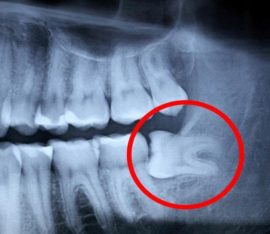 Due to the high probability of the development of pathologies in the formation of wisdom teeth, before removing them, an X-ray examination is necessary. With a curved position relative to the dentition or incomplete eruption, the procedure is mandatory. With the help of an x-ray, the doctor receives information that helps to quickly and painlessly perform even complex surgery:
Due to the high probability of the development of pathologies in the formation of wisdom teeth, before removing them, an X-ray examination is necessary. With a curved position relative to the dentition or incomplete eruption, the procedure is mandatory. With the help of an x-ray, the doctor receives information that helps to quickly and painlessly perform even complex surgery:
- the inclination and length of the tooth, as well as the parameters of the hole;
- position relative to bone tissue and adjacent tooth;
- root system geometry;
- penetration of the root of the tooth into the maxillary sinus.
Sometimes an x-ray is necessary after an operation to remove a wisdom tooth. With prolonged and painful healing of the wound, the picture will show the presence of the remaining solid parts or exclude such a probability.
Simple removal procedure
Any procedure for removing a wisdom tooth is classified as a surgical operation. Removing a wisdom tooth in the upper jaw is a simpler procedure than with the lower. If it is located correctly, completely cut through, and the inflammatory process does not go into a difficult stage, then there is a simple tooth extraction. Then the actions take place in the following order:
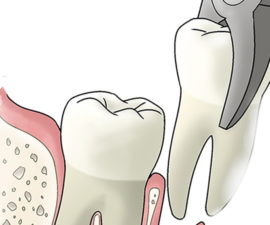 Interrogation of the patient. Includes information on sensations, serious illnesses, medications taken, allergic reactions, problems with blood coagulation and the period of critical days in women.
Interrogation of the patient. Includes information on sensations, serious illnesses, medications taken, allergic reactions, problems with blood coagulation and the period of critical days in women.- Anesthesia With inflammation of the mucous membrane, an injection can cause pain. The onset of the effect lasts from 4 to 8 minutes.
- Tooth extraction. The bottom line is its loosening and subsequent removal. Dentists usually get by with forceps and an elevator, and the procedure itself lasts no more than 10 minutes.
- Well treatment. Anti-inflammatory drugs are laid in the wound, having previously treated it with antiseptics. Suturing is carried out only in the absence of inflammation.
Nuances of surgery for complications
If there are pathologies in the structure of the tooth or if its position is incorrect, the operation is classified as a complex removal of a wisdom tooth. Extraction in the presence of an extensive inflammatory process is of the same type.
Most often, these situations lead to a complex operation:
- The horizontal location of the tooth. After removal, a long healing process begins. The procedure is complicated by the possible partial damage to the seventh tooth.
- The presence of a partially or partially retarded tooth located under the gum. Often complicated by soft tissue inflammation.
- Extensive crown destruction. It indicates a late visit to the doctor.
- The presence of a curved root system. The roots can go to the maxillary sinus, and there is also a risk of damage to the facial nerve.
The process of removing a wisdom tooth has differences in comparison with the extraction of molars or incisors. First, its lower part is released from soft and bone tissue. A gum incision is made with a scalpel, using a drill, a portion of the bone is removed, then the tooth is loosened and removed.
If the presence of a branched network of roots does not allow tooth extraction, then it is sawn and fragments are removed in parts. In this case, the operation can last about an hour.
When a wisdom tooth is removed as planned, and the patient has no contraindications, then general anesthesia is allowed. Not all clinics provide this service, so the information must be checked with the dentist.
Ultrasound removal
Operations on bone tissue using ultrasound waves are increasingly being used in dentistry. In addition to light procedures, such as cleaning the oral cavity from stone, this technology is also effective in complex operations to remove a wisdom tooth.
The main advantage of the method is the absence of the risk of injury due to mechanical stress. The rapid rotation of the drill leads to heating and subsequent necrosis of soft tissues, which prevents rapid healing. Strong physical pressure is fraught with trauma to the palate or jaw, and there is also a risk of damage to the jaw nerve.
The ease of the operation to remove the wisdom tooth in hard-to-reach places is important. The rotating tool is large and difficult to control in a limited space. The piezoelectric tool allows you to do more precise manipulations, which simplifies healing, especially after a difficult case.
Therefore, in complex operations, as well as when a wisdom tooth is removed on the lower jaw, the use of ultrasound surgery is justified. In Moscow and major Russian cities, a large number of clinics already use this method. The only negative is the higher cost of such a procedure.
Postoperative recommendations
After tooth extraction, you must adhere to the doctor's recommendations. The main requirements for the patient for the postoperative period are as follows:
- Observe the timing and volume of painkillers and anti-inflammatory drugs. This also applies to rinsing the oral cavity, which many neglect.
- Observe dietary requirements. Hot and solid foods should not be taken during the healing period.
- Take measures to prevent overpressure. You can not drink alcohol, a large amount of coffee. It is necessary to exclude strong physical activity.
- It is necessary to take measures to prevent an abundant flow of blood to the head. You can not bend down often; sleeping is recommended on a high pillow.
- Follow recommendations for brushing your teeth. The first three days do not recommend brushing your teeth, this is done in order to prevent physical effects of the brush on the wound.
After operation pain may occur within two or three days and a slight fever. This is a normal reaction of the body to surgery.
If the fever is observed for more than three days, the pain persists, chills, an unpleasant smell, swelling of the tooth extraction site has occurred, then you should contact your dentist for an examination and make a decision to resolve the problems.
An operation to remove a wisdom tooth should be performed in clinics that have a good reputation. Factors such as the experience of the dentist and the high-quality technical equipment of the workplace contribute to the easy passage of the removal procedure and minimize the risk of complications.

